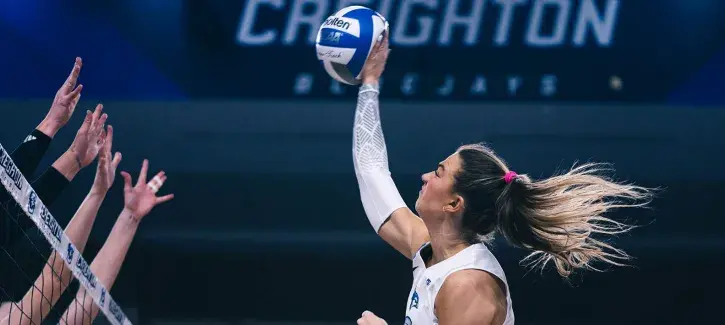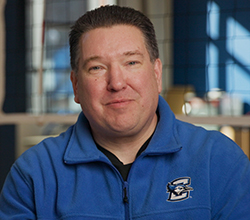
The physics of the volleyball kill

It happens in an instant — a perfectly timed leap, an arm swinging with precision and the unmistakable sound of a volleyball smacking the court. The “kill” — volleyball’s ultimate offensive weapon — is a moment of raw athleticism that can change the trajectory of a game. But what if the secret to this signature play isn’t just skill, but science?
Gintaras Duda, PhD, professor and chair of physics and lifelong volleyball enthusiast, has a unique perspective on the science behind the sport. Growing up in Southern California, where volleyball culture thrives, he played backyard matches with his family and honed his appreciation for the game’s complexity. Today, he translates that passion into a physics lesson, revealing the hidden mechanics of what makes a kill successful.
“Physics is all around us,” Duda says. “Everything we do is dictated by the laws of physics. Understanding those principles — how the body moves, how forces work — can help players fine-tune their performance. A kill, for example, is a perfect combination of biomechanics, timing and power.”

Jumping is foundational to the kill. A hitter must rise above the net, which stands 7 feet, 4 inches tall for women and 8 feet for men, and outmaneuver blockers who may reach heights well over 9 feet during a jump. For a hitter, every inch matters.
“The higher you can jump, the more options you have to attack different areas of the court,” Duda explains. “Players bend their knees and swing their arms to generate force. The longer they stay in contact with the ground before takeoff, the more force they can exert — and the higher they can jump.”
Once airborne, the hitter’s arm becomes the star of the show. Swing mechanics and arm speed dictate the velocity of the ball, with NCAA women’s players averaging 40 to 60 mph on a kill. According to Duda, the key lies in momentum transfer.
“When the hand hits the ball, it’s a collision,” he says. “The faster your arm moves, the more momentum you transfer to the ball. That’s why swinging mechanics are so important — you want to maximize speed at the point of impact.”
He likens the arm’s movement to a merry-go-round. “The farther out you go from the rotation point, the faster the linear velocity. That’s why a strong shoulder rotation and a full arm swing are critical.”
Behind every great kill is an equally great set. The setter’s job is to place the ball in the perfect position, allowing the hitter to execute their attack. Precision is paramount — too close to the net, and blockers gain the advantage; too far, and the hitter’s options shrink. Duda emphasizes that this interplay between setter and hitter requires “meticulous practice and incredible team chemistry.”
Indeed, those two elements lie at the heart of Creighton’s volleyball success. This past season, Creighton won its 11th straight BIG EAST regular-season title (finishing a perfect 18-0 in conference play), and 10th BIG EAST Tournament title in 11 years, en route to earning its 13th straight NCAA Tournament bid and reaching the Elite Eight for the second time in program history.
“It’s not just about power — it’s about being in the right place at the right time to create opportunities. Creighton’s team chemistry is a huge factor in their success,” Duda explains.
This cohesion turns physics into an art, allowing the Bluejays to execute the kill with unparalleled finesse. Whether it’s a perfectly timed jump or a split-second reaction on defense, Creighton’s players embody the scientific and strategic mastery that defines top-tier volleyball.




